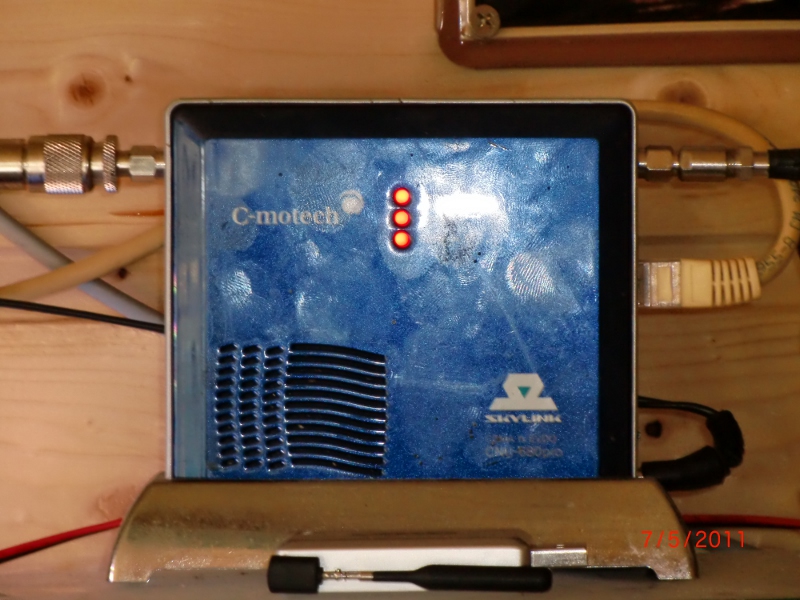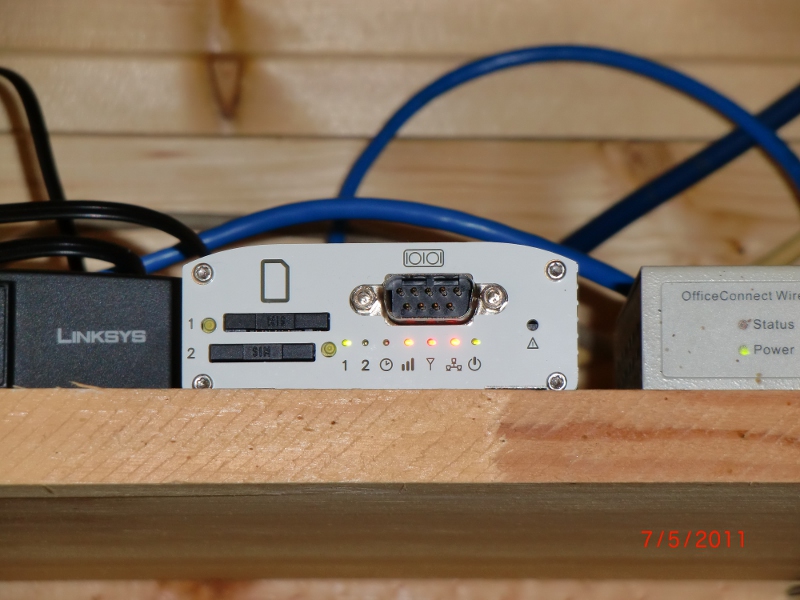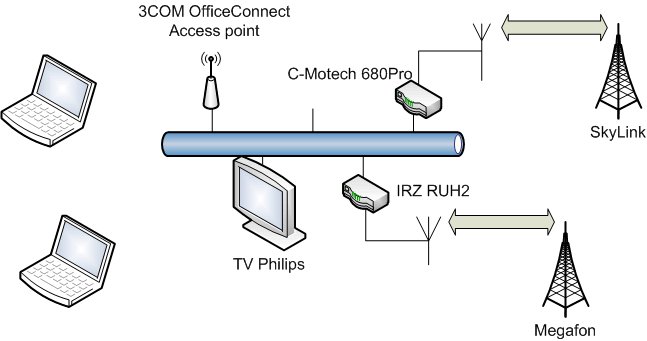Country Internet
The need to be connected to the Internet constantly, even on vacation in the country, has long been not a luxury, but an absolute must. The article describes the way to get a stable mobile Internet on a single cottage near Moscow. In anticipation of summer, the material may seem interesting to someone.
The history of the Internet in the country began about seven years ago. Cottage in the suburbs in the area Tuchkovo. Naturally, in the cottages is not that optics, but the wired phone was not. So at first I tried the only relatively fast operator at that time - Skylink with a USB modem. It was possible to work, but it is very sad, because confidently worked only on the street.
Working on the street is not always pleasant, so I had to buy a C-motech 550Pro router and attach a Wi-Fi point to it. It has become much better. Sometimes even 2 laptops could work normally.
Began to experiment further. I bought a circular antenna and put it on a pole above the house. The result pleased, because Stability has increased significantly. And with the installation of a directional antenna, life has become beautiful.
As a result, 2-3 laptops could surf the Web. The actual incoming speed was about 300 Kb / s, the outgoing speed was significantly lower.
Three years ago, after throwing power, C-motech 550th ordered to live long and I changed it to C-motech 680Pro. This is a more advanced router with two antennas. One works only for reception, the other for reception and transmission. He delivered a second directional antenna and began to enjoy surfing.

C-motech 680Pro. Right and left cables are suitable for external directional antennas. Before him is an old USB modem Skylink
')
They strained only two problems - sometimes, especially in the evenings, it was not very comfortable to work with an office computer via RDP, and the office phone on such a channel refused to work. Those. I heard everyone well (the incoming channel allowed), and from me the subscribers regularly heard only “Kva-Kva-Kva”.
In April 11, a 3G from Megafon appeared in our district. According to the coverage map published on their website, it appeared that I was just on the border of 3G coverage. Making 3G work from a megaphone at the border of 3G action turned out to be quite an interesting task.
At first, I took on trial a set of sims and a USB modem. 3G was relatively stable on the street and at the window on the second floor. The connection speed on the set of tests was significantly higher than that of Skylink, reaching 2.1 Mb / s, but the ping was significantly worse. And the cost options differed significantly not in favor of skylink. Based on the test, I decided to put the megaphone as the main provider, and leave Skylink in reserve.
Action plan: connect a second router with a standard antenna to the existing infrastructure, check the possibility of stable operation, and then think about a directional antenna.
I took IRZ RUH2 as a router. Brought, connected, after turning off DHCP.
Antenna put on the window. All weekend, tested the speed and controlled modes. The result: a little better than a whistle, but still falls regularly in EDGE. I had to put a directional antenna.

IRZ RUH Router 2. One SIM card is installed. On the right is visible part of the access point, on the left - the switch.
Router liked. At the heart of - Linux. Pleasantly surprised by iptables explicitly. It can work with two SIM cards, switching from provider to provider, has a COM port for connecting external controllers, there is a USB connector, but I have not tried it as a file server yet. It also offers DynDNS, the ability to run scripts on a schedule, OpenVPN client and server. In 3G SIP mode, the phone showed pretty good call quality, i.e. no longer kvakal, but some of the words disappeared.
A week later, he set up a directional antenna. The signal has become much more stable and almost all the time in HSDPA mode, sometimes dropping to UMTS. No EDGE in sight is not visible. SIP phone works just fine. The download speed in the evening, on average, 1.3Mb / s, and unloading 0.3.

Here is the antenna pole. The top two antennas are from Skylink, the small bottom ones are from Megaphone.
I finally switched to a new router simply by turning it off on the old DHCP and lifting it on the new one. Since both routers still have limited functionality, I was unable to configure automatic switching to a backup router when the main connection was lost. I registered static addresses on my laptops, thankfully, I use Lenovo, which has Access Connection and you can manage settings for each location, and guests will not work in backup mode.
Stability of work is ensured by a daily reboot at 7 am, the benefit of this opportunity in the IRZ, too.
As a result, at the beginning of summer I have the following network topology:

Over the past summer all had to switch to Skylink only three or four times. Truth once switched by phone, explaining to his wife what to include and what parameters to change.
In the fall I decided to buy a webcam, and in order to be able to view what was going on in the house and in the vicinity from anywhere, I had to raise a VPN connection to the office using OpenVPN. The benefit and this functionality in the IRZ is.
Recently I solved the problem with routing automation: I installed another Linksys RV042 router. This is a pretty good budget machine with two WAN ports. The result was a pretty heaped up and completely autonomous local network to which a TV, telephone, camera and access point are connected, and the whole economy protects a thousand-watt UPS APC SmartUPS from problems with electricity.
And also, Altusen's Power Ower IP is running on the farm. While he is lying on the shelf, but soon he will also turn on the network and control the sauna and electric heaters.
The history of the Internet in the country began about seven years ago. Cottage in the suburbs in the area Tuchkovo. Naturally, in the cottages is not that optics, but the wired phone was not. So at first I tried the only relatively fast operator at that time - Skylink with a USB modem. It was possible to work, but it is very sad, because confidently worked only on the street.
Working on the street is not always pleasant, so I had to buy a C-motech 550Pro router and attach a Wi-Fi point to it. It has become much better. Sometimes even 2 laptops could work normally.
Began to experiment further. I bought a circular antenna and put it on a pole above the house. The result pleased, because Stability has increased significantly. And with the installation of a directional antenna, life has become beautiful.
As a result, 2-3 laptops could surf the Web. The actual incoming speed was about 300 Kb / s, the outgoing speed was significantly lower.
Three years ago, after throwing power, C-motech 550th ordered to live long and I changed it to C-motech 680Pro. This is a more advanced router with two antennas. One works only for reception, the other for reception and transmission. He delivered a second directional antenna and began to enjoy surfing.

C-motech 680Pro. Right and left cables are suitable for external directional antennas. Before him is an old USB modem Skylink
')
They strained only two problems - sometimes, especially in the evenings, it was not very comfortable to work with an office computer via RDP, and the office phone on such a channel refused to work. Those. I heard everyone well (the incoming channel allowed), and from me the subscribers regularly heard only “Kva-Kva-Kva”.
In April 11, a 3G from Megafon appeared in our district. According to the coverage map published on their website, it appeared that I was just on the border of 3G coverage. Making 3G work from a megaphone at the border of 3G action turned out to be quite an interesting task.
At first, I took on trial a set of sims and a USB modem. 3G was relatively stable on the street and at the window on the second floor. The connection speed on the set of tests was significantly higher than that of Skylink, reaching 2.1 Mb / s, but the ping was significantly worse. And the cost options differed significantly not in favor of skylink. Based on the test, I decided to put the megaphone as the main provider, and leave Skylink in reserve.
Action plan: connect a second router with a standard antenna to the existing infrastructure, check the possibility of stable operation, and then think about a directional antenna.
I took IRZ RUH2 as a router. Brought, connected, after turning off DHCP.
Antenna put on the window. All weekend, tested the speed and controlled modes. The result: a little better than a whistle, but still falls regularly in EDGE. I had to put a directional antenna.

IRZ RUH Router 2. One SIM card is installed. On the right is visible part of the access point, on the left - the switch.
Router liked. At the heart of - Linux. Pleasantly surprised by iptables explicitly. It can work with two SIM cards, switching from provider to provider, has a COM port for connecting external controllers, there is a USB connector, but I have not tried it as a file server yet. It also offers DynDNS, the ability to run scripts on a schedule, OpenVPN client and server. In 3G SIP mode, the phone showed pretty good call quality, i.e. no longer kvakal, but some of the words disappeared.
A week later, he set up a directional antenna. The signal has become much more stable and almost all the time in HSDPA mode, sometimes dropping to UMTS. No EDGE in sight is not visible. SIP phone works just fine. The download speed in the evening, on average, 1.3Mb / s, and unloading 0.3.

Here is the antenna pole. The top two antennas are from Skylink, the small bottom ones are from Megaphone.
I finally switched to a new router simply by turning it off on the old DHCP and lifting it on the new one. Since both routers still have limited functionality, I was unable to configure automatic switching to a backup router when the main connection was lost. I registered static addresses on my laptops, thankfully, I use Lenovo, which has Access Connection and you can manage settings for each location, and guests will not work in backup mode.
Stability of work is ensured by a daily reboot at 7 am, the benefit of this opportunity in the IRZ, too.
As a result, at the beginning of summer I have the following network topology:

Over the past summer all had to switch to Skylink only three or four times. Truth once switched by phone, explaining to his wife what to include and what parameters to change.
In the fall I decided to buy a webcam, and in order to be able to view what was going on in the house and in the vicinity from anywhere, I had to raise a VPN connection to the office using OpenVPN. The benefit and this functionality in the IRZ is.
Recently I solved the problem with routing automation: I installed another Linksys RV042 router. This is a pretty good budget machine with two WAN ports. The result was a pretty heaped up and completely autonomous local network to which a TV, telephone, camera and access point are connected, and the whole economy protects a thousand-watt UPS APC SmartUPS from problems with electricity.
And also, Altusen's Power Ower IP is running on the farm. While he is lying on the shelf, but soon he will also turn on the network and control the sauna and electric heaters.
Source: https://habr.com/ru/post/141114/
All Articles